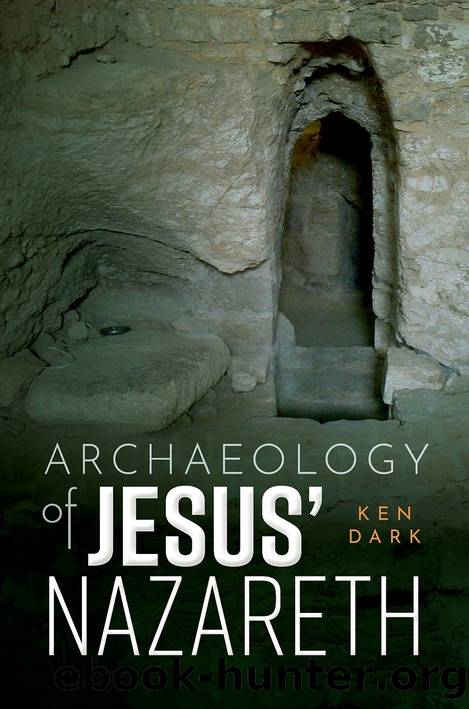Archaeology of Jesus' Nazareth by Ken Dark;

Author:Ken Dark; [Dark, Ken]
Language: eng
Format: epub
ISBN: 9780192688996
Publisher: Oxford University Press USA
Published: 2022-11-23T00:00:00+00:00
Senès in the museum
By 1936, the convent museum was already packed with archaeological objects of many different sorts. There were coins and other metal artefacts, shards of glass and sherds of pottery, along with stone objects of various sizes from beads and individual mosaic cubes to the shafts of stone columns that once supported parts of buildings.
Senès went through these finds, putting the smaller objects in wooden crates, cardboard boxes, and reused food boxes or tin cans. Old tobacco tins were a Senès favourite.
Most of the surviving objects in the convent museum were in these containers when I first saw them in 2006. Although some still had his handwritten labels, many were unlabelled. Judging from surviving French labels in several different types of handwriting, it looks as if, when he sorted through the finds, some were already labelled.
Using his own knowledge of finds from elsewhere and probably, at least for some items, existing labels, he attempted to identify and date the objects. Occasionally, his labels also give the find-spot or other details of the object. But most just give a category of objects, such as pottery or glass.
It might be expected that all the objects in the convent museum come from the convent. This was my own initial assumption when I first saw the museum in 2005. It seems to be an assumption shared with many others who have visited the site. But it is certainly incorrect.
Senèsâ labels note that some objects which are still in the museum came from locations outside Nazareth. These, he tells us, come from places such as Kefar Kana, Acre, and âEilabounâ (Eilabun). There were once more such objects, for example a now-lost pottery lamp described in his notes as having been given to the convent museum from the excavation at Tabgha on the Sea of Galilee.
There is no indication that any of the larger pieces of worked stone came from elsewhere. Many were certainly found at the convent, because they are described in the nunsâ nineteenth- and early twentieth-century notes. However, even a piece of mosaic floor is described by Senès as being from the âancient tombsâ of âChef-Amarâ (Shefa-Ê»Amr)âa site where Byzantine rock-cut tombs were found in the nineteenth century and where there was another convent belonging to the Sisters of Nazareth.
There is no suggestion that any of this material was being passed off as from the convent excavations. Neither the nuns nor Senès felt that they needed to fabricate anything to prove that the site was what they said it was. On its labels, the outside origin of the material is made clear.
Nevertheless, given that most of the finds in the museum are unlabelled, just because an object is in the convent museum doesnât mean that object was found at the convent. This, combined with the fact that many of the cardboard and wooden boxes, and other objects displayed on the museum shelves, are unlabelled, means that the vast majority of objects in the museum are useless for interpreting the site.
What is more, what is left in the museum is likely to be an unrepresentative sample of what was found.
Download
This site does not store any files on its server. We only index and link to content provided by other sites. Please contact the content providers to delete copyright contents if any and email us, we'll remove relevant links or contents immediately.
| Africa | Americas |
| Arctic & Antarctica | Asia |
| Australia & Oceania | Europe |
| Middle East | Russia |
| United States | World |
| Ancient Civilizations | Military |
| Historical Study & Educational Resources |
Cecilia; Or, Memoirs of an Heiress — Volume 1 by Fanny Burney(32062)
Cecilia; Or, Memoirs of an Heiress — Volume 3 by Fanny Burney(31458)
Cecilia; Or, Memoirs of an Heiress — Volume 2 by Fanny Burney(31409)
The Secret History by Donna Tartt(18163)
Sapiens: A Brief History of Humankind by Yuval Noah Harari(13991)
Leonardo da Vinci by Walter Isaacson(12804)
The Radium Girls by Kate Moore(11621)
Sapiens by Yuval Noah Harari(5123)
How Democracies Die by Steven Levitsky & Daniel Ziblatt(4958)
The Wind in My Hair by Masih Alinejad(4843)
Homo Deus: A Brief History of Tomorrow by Yuval Noah Harari(4690)
Endurance: Shackleton's Incredible Voyage by Alfred Lansing(4507)
Man's Search for Meaning by Viktor Frankl(4275)
The Silk Roads by Peter Frankopan(4274)
Millionaire: The Philanderer, Gambler, and Duelist Who Invented Modern Finance by Janet Gleeson(4099)
The Rape of Nanking by Iris Chang(4023)
Hitler in Los Angeles by Steven J. Ross(3798)
The Motorcycle Diaries by Ernesto Che Guevara(3787)
Joan of Arc by Mary Gordon(3782)
